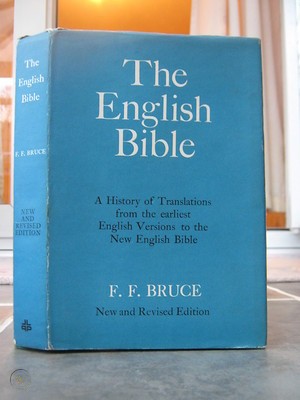
F.F. Bruce is one of those giants of 20th Century evangelicalism that doesn’t quite make it over the Protestant/Catholic divide. Born in Scotland in 1910 and raised in Plymouth Brethren-style Christianity, he wrote both scholarly and popular works on the New Testament. Many of his books are still in print, notably “Paul: Apostle of the Heart Set Free” and “The New Testament Documents: Are They Reliable?” To give an idea of the sort of crowd who read his books and viewed him as an esteemed peer, a book of essays on Bruce’s work published to celebrate his 60th birthday featured pieces by Bruce Metzger (mastermind behind the NRSV) and William Barclay (whose New Testament commentaries were enthusiastically read by Bishop Fulton Sheen).
That same year, F.F. Bruce published the second edition of his book “ The English Bible”. Much like Bruce Metzger would years later, it is a survey of the history of English bible translation in the form of analyses of the major translations. It differs from Metzger’s later effort with its British perspective, greater detail, and, to be perfectly frank, much more interesting prose.
When I reproduced some of Metzger’s comments on major Catholic translations on this website last year, I commented on the (understandable) lack of an assessment on the Knox Bible in that work. Well, when a college friend gave me a bag of books that had belonged to her Episcopal priest mother, I was delighted to find that F.F. Bruce devoted almost an entire chapter to the Knox! So let’s see how this younger contemporary of the witty Monsignor assessed this cult-classic of a translation…
On Knox’s Two Psalters
The first place the Knox version is mentioned is actually during Bruce’s comments on the Douay Psalter.
A few years back when I found a used copy of the two volume Knox Old Testament, I was surprised to find there were two Psalters, one in its normal position and the other in the appendix after “Machabees”. Bruce notes that the first is a translation of the Gallican Psalter—the Latin translation of the Septuagint psalms canonized by hundreds of years of liturgical use but notoriously obscure in many parts. (The Douay psalter is also a translation of the Gallican Psalter.) F.F. Bruce, using the example of Psalms 68:12 (67:13 in Vulgate numbering) writes that, “when Mgr Knox, in his turn, had to see what he could make of the Gallican Psalter here, he produced, as might be expected, something that was good English, but something which inevitably bore little relation to the Psalmist’s meaning and not very much to the construction of the Gallican Psalter.”
Bruce notes that Knox ties in the verse in question with the one previous and renders the idea as “Here are bringers of good news, with a message the Lord has given them, from the army he leads; a king, leading the armies of a beloved people; a people how well beloved! He bids the favourites of his court divide the spoil between them.”
The second psalter from Knox’s appendix was a translation of the 1945 new Latin psalms translated from the Hebrew by the Pontifical Biblical Institute. (This psalter, sometimes known as the Pian Psalter or the Bea Psalter was also the base text of the NAB psalter until 1991.) When the first one-volume Knox Bibles were compiled, it was the translation of the new Latin psalms, not the Gallican, which were included. This remains true to this day with the Baronius Press edition of the Knox. In this psalter, the parallel to the previous quote is “Routed the kings, routed their armies; they have left their spoils for housewives to carry away.” Bruce notes that this is also the thrust of the verse in the King James.
The large difference between these two versions gives me an idea for a possible future breakdown of a few familiar Psalms to see the differences between the Gallican and Pian Psalters in their respective Knox translations.
While the above comments might give you impression that F.F. Bruce is keen to take the Douay Rheims behind the woodshed, he is not shy about complimenting the Douay-Rheims highly when he sees fit. If there is interest among the commentariat, I might write on Bruce’s analysis of that translation, as unfamiliar with it as I am.
Stay tuned for part 2!
Thanks for this, Bob (and Marc). It’s good to have something interesting to read other than the usual of late— this is a nice diversion! It’s important to stay informed, but also to stay connected to our interests and not let ourselves be overwhelmed by the news cycle.
My Knox Bible has been on the shelf for a while. I should pull it off and get reacquainted. I’ve been reading the ESV mostly, since the Catholic edition came out, but lately, more and more, I’m reading and praying with the St. Joseph’s New Catholic Bible, which I’m impressed with. So far, I’m finding it flows much better than the NABRE.
Bob,
This is wonderful. As a Knox fan I will eagerly be tuning in to read. Thank you!
Seconded! Anything regarding Knox and his bible are welcome fare to me!